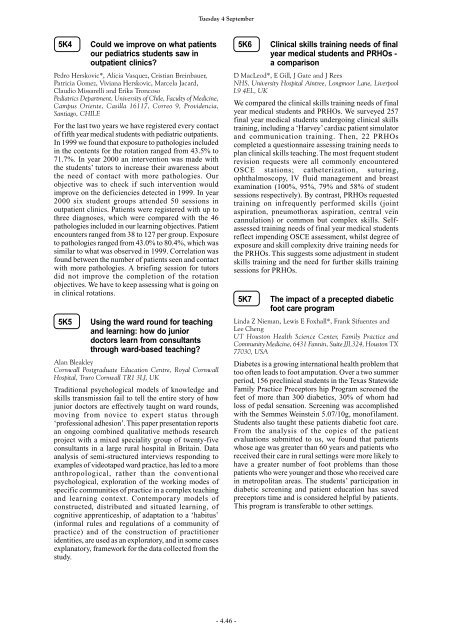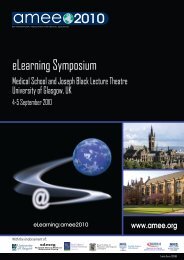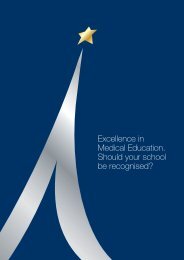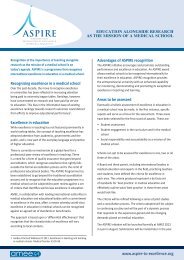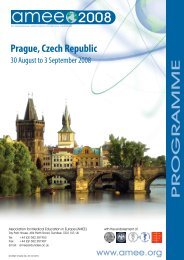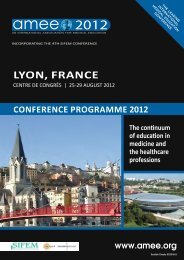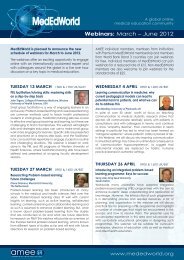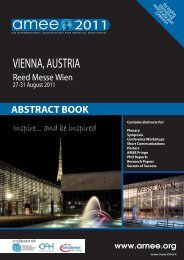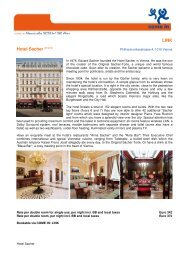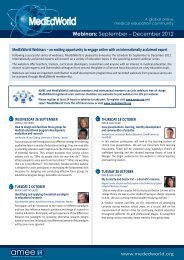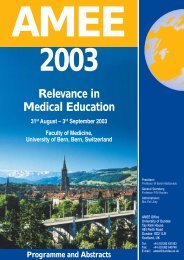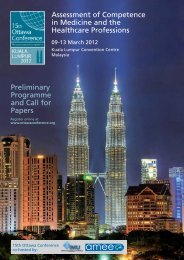AMEE Berlin 2002 Programme
AMEE Berlin 2002 Programme
AMEE Berlin 2002 Programme
Create successful ePaper yourself
Turn your PDF publications into a flip-book with our unique Google optimized e-Paper software.
5K4 Could we improve on what patients<br />
our pediatrics students saw in<br />
outpatient clinics?<br />
Pedro Herskovic*, Alicia Vasquez, Cristian Breinbauer,<br />
Patricia Gomez, Viviana Herskovic, Marcela Jacard,<br />
Claudio Missarelli and Erika Troncoso<br />
Pediatrics Department, University of Chile, Faculty of Medicine,<br />
Campus Oriente, Casilla 16117, Correo 9, Providencia,<br />
Santiago, CHILE<br />
For the last two years we have registered every contact<br />
of fifth year medical students with pediatric outpatients.<br />
In 1999 we found that exposure to pathologies included<br />
in the contents for the rotation ranged from 43.5% to<br />
71.7%. In year 2000 an intervention was made with<br />
the students’ tutors to increase their awareness about<br />
the need of contact with more pathologies. Our<br />
objective was to check if such intervention would<br />
improve on the deficiencies detected in 1999. In year<br />
2000 six student groups attended 50 sessions in<br />
outpatient clinics. Patients were registered with up to<br />
three diagnoses, which were compared with the 46<br />
pathologies included in our learning objectives. Patient<br />
encounters ranged from 38 to 127 per group. Exposure<br />
to pathologies ranged from 43.0% to 80.4%, which was<br />
similar to what was observed in 1999. Correlation was<br />
found between the number of patients seen and contact<br />
with more pathologies. A briefing session for tutors<br />
did not improve the completion of the rotation<br />
objectives. We have to keep assessing what is going on<br />
in clinical rotations.<br />
5K5 Using the ward round for teaching<br />
and learning: how do junior<br />
doctors learn from consultants<br />
through ward-based teaching?<br />
Alan Bleakley<br />
Cornwall Postgraduate Education Centre, Royal Cornwall<br />
Hospital, Truro Cornwall TR1 3LJ, UK<br />
Traditional psychological models of knowledge and<br />
skills transmission fail to tell the entire story of how<br />
junior doctors are effectively taught on ward rounds,<br />
moving from novice to expert status through<br />
‘professional adhesion’. This paper presentation reports<br />
an ongoing combined qualitative methods research<br />
project with a mixed speciality group of twenty-five<br />
consultants in a large rural hospital in Britain. Data<br />
analysis of semi-structured interviews responding to<br />
examples of videotaped ward practice, has led to a more<br />
anthropological, rather than the conventional<br />
psychological, exploration of the working modes of<br />
specific communities of practice in a complex teaching<br />
and learning context. Contemporary models of<br />
constructed, distributed and situated learning, of<br />
cognitive apprenticeship, of adaptation to a ‘habitus’<br />
(informal rules and regulations of a community of<br />
practice) and of the construction of practitioner<br />
identities, are used as an exploratory, and in some cases<br />
explanatory, framework for the data collected from the<br />
study.<br />
Tuesday 4 September<br />
- 4.46 -<br />
5K6 Clinical skills training needs of final<br />
year medical students and PRHOs -<br />
a comparison<br />
D MacLeod*, E Gill, J Gate and J Rees<br />
NHS, University Hospital Aintree, Longmoor Lane, Liverpool<br />
L9 4EL, UK<br />
We compared the clinical skills training needs of final<br />
year medical students and PRHOs. We surveyed 257<br />
final year medical students undergoing clinical skills<br />
training, including a ‘Harvey’ cardiac patient simulator<br />
and communication training. Then, 22 PRHOs<br />
completed a questionnaire assessing training needs to<br />
plan clinical skills teaching. The most frequent student<br />
revision requests were all commonly encountered<br />
OSCE stations; catheterization, suturing,<br />
ophthalmoscopy, IV fluid management and breast<br />
examination (100%, 95%, 79% and 58% of student<br />
sessions respectively). By contrast, PRHOs requested<br />
training on infrequently performed skills (joint<br />
aspiration, pneumothorax aspiration, central vein<br />
cannulation) or common but complex skills. Selfassessed<br />
training needs of final year medical students<br />
reflect impending OSCE assessment, whilst degree of<br />
exposure and skill complexity drive training needs for<br />
the PRHOs. This suggests some adjustment in student<br />
skills training and the need for further skills training<br />
sessions for PRHOs.<br />
5K7 The impact of a precepted diabetic<br />
foot care program<br />
Linda Z Nieman, Lewis E Foxhall*, Frank Sifuentes and<br />
Lee Cheng<br />
UT Houston Health Science Center, Family Practice and<br />
Community Medicine, 6431 Fannin, Suite JJL324, Houston TX<br />
77030, USA<br />
Diabetes is a growing international health problem that<br />
too often leads to foot amputation. Over a two summer<br />
period, 156 preclinical students in the Texas Statewide<br />
Family Practice Preceptors hip Program screened the<br />
feet of more than 300 diabetics, 30% of whom had<br />
loss of pedal sensation. Screening was accomplished<br />
with the Semmes Weinstein 5.07/10g, monofilament.<br />
Students also taught these patients diabetic foot care.<br />
From the analysis of the copies of the patient<br />
evaluations submitted to us, we found that patients<br />
whose age was greater than 60 years and patients who<br />
received their care in rural settings were more likely to<br />
have a greater number of foot problems than those<br />
patients who were younger and those who received care<br />
in metropolitan areas. The students’ participation in<br />
diabetic screening and patient education has saved<br />
preceptors time and is considered helpful by patients.<br />
This program is transferable to other settings.


